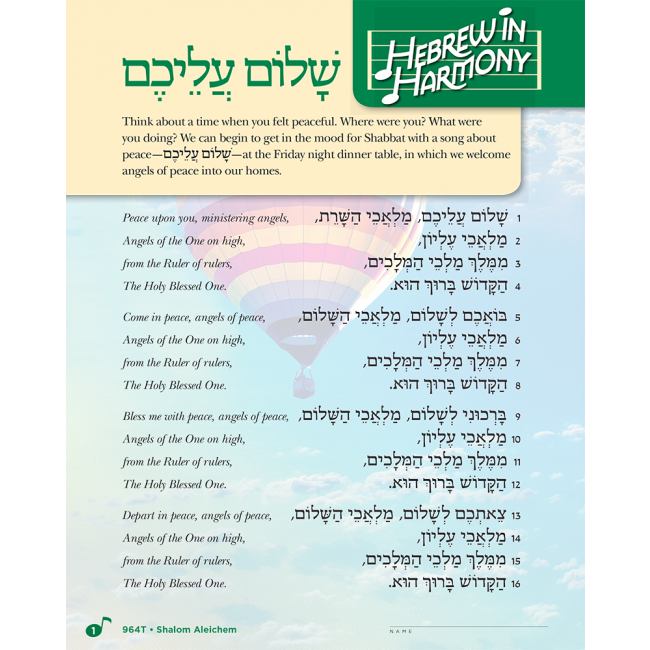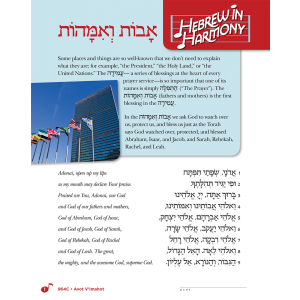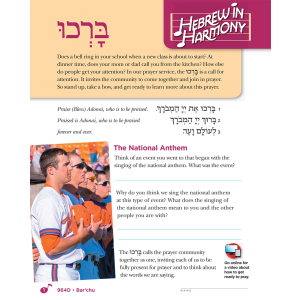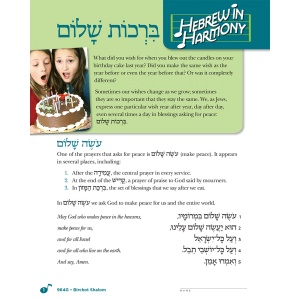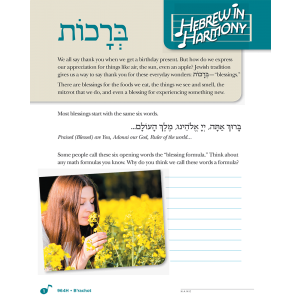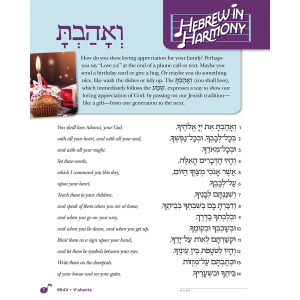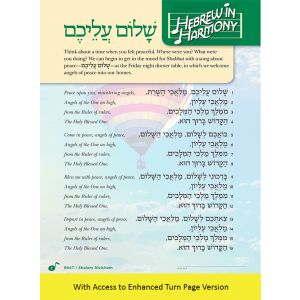Hebrew in Harmony: Shalom Aleichem
This 16-page journal is the student’s hands-on tool for making personal meaning of Shalom Aleichem.
This 16-page journal is the student’s hands-on tool for making personal meaning of Shalom Aleichem and other elements of Shabbat. It includes Hebrew reading practice, drawing and other reflection activities, music interpretation, and a variety of prompts for personal relevance. Three “Hebrew Helpers” pages reinforce reading, vocabulary, roots and prayer concepts. Each journal ends with “My Musical Journey”—a summary and assessment page.
In addition to its use as a skills-building and reflection tool, the journal can serve as a record of progress and is an excellent way for students to build a portfolio of their work.
Hebrew in Harmony is a 3-year Hebrew curriculum for 4th-6th graders that uses the power of music to engage students with prayer.
Educators can select from among 22 individual modules—each devoted to a different prayer—and teach them in any order. Featuring music from today’s top Jewish musicians, along with arts, movement, videos, and a full digital learning experience, this multimedia curriculum invites students to learn to sing and pray in Hebrew, as well as read, explore, and interpret prayer text.
Goals and Enduring Understandings for each module can be found here. (For a Word version, click here.)
A list of the prayers in the series can be found here.
For each prayer, there are 3 components:
Student Journals - One 16-page booklet per prayer that includes Hebrew reading, drawing, and other reflection activities, music interpretation, and a variety of other prompts for personal relevance. Click here to sample the Sh'ma student journal.
Enhanced Turn-page Access - Online music, videos, and prayer practice.
Curriculum Core - A three-ring binder with fully scripted, timed lesson plans to create dynamic multimedia lessons, student journal booklet answer keys, reproducible word cards, and song lyrics for the music included in that module. Includes art, mindfulness, and movement activities. Click here for a sample lesson from the Sh'ma Curriculum Core.
Why teach prayer through music?
The reasons are many: Music creates a safe and welcoming environment rich with opportunities for learning. Research shows a link between music and emotion, and students learn best when new information is associated with strong emotion and engagement. Music also acts as a powerful memory device. Plus, music adds joy and fun to Hebrew learning.
Do I need musical skills to teach Hebrew in Harmony?
No! The beauty of Hebrew in Harmony is its roster of fabulous professional musicians who are virtual teachers during the music portions of each lesson. Each lesson is fully scripted, so when it says to “play the music,” just play the music.
Is Hebrew in Harmony appropriate for a particular movement/affiliation?
Hebrew in Harmony is designed to be used by educators and students of any affiliation. Where liturgical differences occur (for example, Avot/Imahot and G’vurot), the variations are presented and explained, and provide a good learning opportunity. In the digital companion, you can choose your affiliation.
What resources are available for introducing Hebrew in Harmony to my teachers or parents?
We have developed a PowerPoint presentation you can share with your staff or community to explain the program. Note that there are "talking points" at the bottom of many of the slides.
Click here to download the presentation, "How to Present Hebrew in Harmony"
What resources are available for teaching Hebrew in Harmony?
This is a totally new way of teaching, and we know you have questions.
The best place to start is with the Curriculum Core, which covers many elements of how to teach with Hebrew in Harmony.
Where is the music for Hebrew in Harmony?
All the music for the series is in the turn-page access. Music for each prayer includes a traditional melody plus 3-4 musical interpretations of the prayer.
How can I try out the program before committing to it?
Be sure to try out the enhanced turn-page access, download a complete student journal , and view sample pages from the Curriculum Core. If you still aren’t sure, get in touch with us to request a 15-minute demonstration.
What People Are Saying
Read how different schools are experiencing Hebrew in Harmony.
Extensive Research Leads One New Jersey School to Hebrew in Harmony
When Congregation Mkor Shalom in Cherry Hill needed a change to its Hebrew program, educators got organized.
Teacher Buy-In and Curriculum Change: A Case Study in Thoughtful Planning
Temple Sinai in Atlanta has advice for fellow educators navigating through Hebrew in Harmony. Read on for helpful tips from professional teachers.
California School Adopts Hebrew in Harmony - Giving Its Education Committee A Voice
When educators at Shir Hama alot in California wanted to adopt Hebrew in Harmony, they made sure to include their education committee in the planning.

